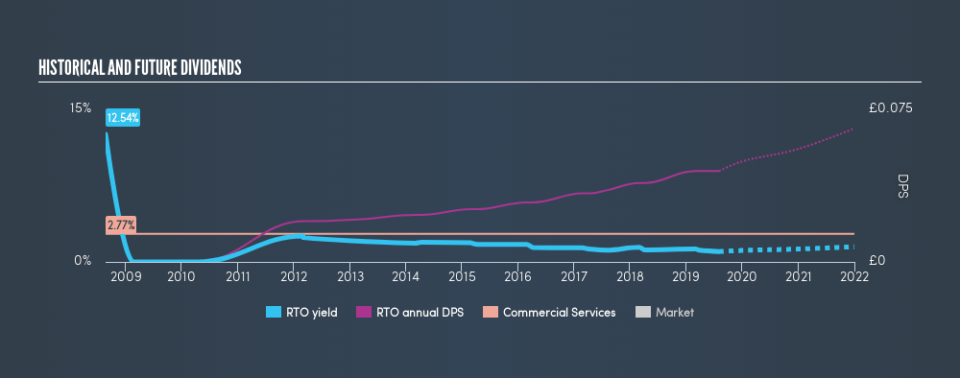Just 3 Days Before Rentokil Initial plc (LON:RTO) Will Be Trading Ex-Dividend

Readers hoping to buy Rentokil Initial plc (LON:RTO) for its dividend will need to make their move shortly, as the stock is about to trade ex-dividend. If you purchase the stock on or after the 8th of August, you won't be eligible to receive this dividend, when it is paid on the 11th of September.
Rentokil Initial's next dividend payment will be UK£0.015 per share, and in the last 12 months, the company paid a total of UK£0.045 per share. Based on the last year's worth of payments, Rentokil Initial stock has a trailing yield of around 1.0% on the current share price of £4.385. We love seeing companies pay a dividend, but it's also important to be sure that laying the golden eggs isn't going to kill our golden goose! So we need to investigate whether Rentokil Initial can afford its dividend, and if the dividend could grow.
Check out our latest analysis for Rentokil Initial
Dividends are typically paid out of company income, so if a company pays out more than it earned, its dividend is usually at a higher risk of being cut. Rentokil Initial reported a loss last year, so it's not great to see that it has continued paying a dividend. Considering the lack of profitability, we also need to check if the company generated enough cash flow to cover the dividend payment. If cash earnings don't cover the dividend, the company would have to pay dividends out of cash in the bank, or by borrowing money, neither of which is long-term sustainable. Thankfully its dividend payments took up just 37% of the free cash flow it generated, which is a comfortable payout ratio.
Click here to see the company's payout ratio, plus analyst estimates of its future dividends.
Have Earnings And Dividends Been Growing?
Companies with consistently growing earnings per share generally make the best dividend stocks, as they usually find it easier to grow dividends per share. If business enters a downturn and the dividend is cut, the company could see its value fall precipitously. Rentokil Initial was unprofitable last year, but at least the general trend suggests its earnings have been improving over the past five years. Even so, an unprofitable company whose business does not quickly recover is usually not a good candidate for dividend investors.
Another key way to measure a company's dividend prospects is by measuring its historical rate of dividend growth. Rentokil Initial has seen its dividend decline 2.7% per annum on average over the past 10 years, which is not great to see.
Get our latest analysis on Rentokil Initial's balance sheet health here.
The Bottom Line
Is Rentokil Initial worth buying for its dividend? It's hard to get used to Rentokil Initial paying a dividend despite reporting a loss over the past year. At least the dividend was covered by free cash flow, however. While it does have some good things going for it, we're a bit ambivalent and it would take more to convince us of Rentokil Initial's dividend merits.
Curious what other investors think of Rentokil Initial? See what analysts are forecasting, with this visualisation of its historical and future estimated earnings and cash flow .
We wouldn't recommend just buying the first dividend stock you see, though. Here's a list of interesting dividend stocks with a greater than 2% yield and an upcoming dividend.
We aim to bring you long-term focused research analysis driven by fundamental data. Note that our analysis may not factor in the latest price-sensitive company announcements or qualitative material.
If you spot an error that warrants correction, please contact the editor at editorial-team@simplywallst.com. This article by Simply Wall St is general in nature. It does not constitute a recommendation to buy or sell any stock, and does not take account of your objectives, or your financial situation. Simply Wall St has no position in the stocks mentioned. Thank you for reading.

 Yahoo Finance
Yahoo Finance 
